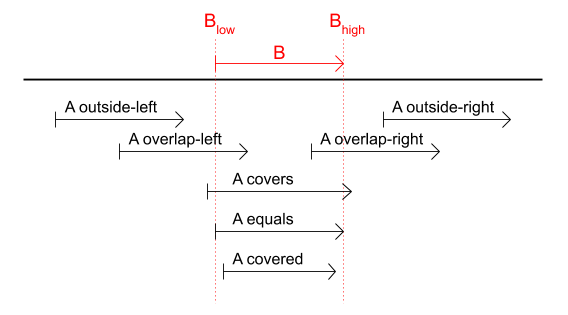Interval¶
Contents
Introduction¶
Interval is used by Dataset and Sequencer to define the validity of objects or values in relation to a timeline. Intervals describe either a continuous line segment or a singular point. In the context of media, intervals define the temporal validity of timed media content.
Definition¶
Following standard mathematical notation intervals are expressed by two endpoint values low and high, where low <= high. Interval endpoints are either open or closed, as indicated with brackets below:
e.g.: [a,b] [a,b) (a,b] (a,b)
If low == high the interval is said to represent a singular point [low, high], or simply [low] for short. Endpoints of singular point intervals are always closed.
Infinity values may be used to create un-bounded intervals. Endpoints with infinite values are always closed.
e.g.: [a, Infinity] [-Infinity, a] [-Infinity, Infinity].
// [4.0] - singular point
itv = new Interval(4.0);
// [4.0] - singular point
itv = new Interval(4.0, 4.0);
// [4,6.1) - interval
itv = new Interval(4.0, 6.1, true, false);
// (4,6.1) - interval
itv = new Interval(4.0, 6.1, false, false);
// [4,6.1] - interval
itv = new Interval(4.0, 6.1, true, true);
// (4,6.1] - interval
itv = new Interval(4.0, 6.1, false, true);
// [4,6.1) - default endpoints
itv = new Interval(4.0, 6.1);
// [4,->] - un-bounded
itv = new Interval(4.0, Infinity);
Endpoint Types¶
Intervals are defined as a pair of interval endpoints. The table below shows that there are four distinct types of endpoints, and that endpoints have three distinct properties
- value: numerical value
- bracket-side: true if high else low
- bracket-type: true if closed else open
| symbol | name | value | bracket-side | bracket-type |
|---|---|---|---|---|
| [a | low-closed | a | false | true |
| (a | low-open | a | false | false |
| a] | high-closed | a | true | true |
| a) | high-open | a | true | false |
Singular intervals have two endpoints [a and a], even though they only have one value. In order to distinguish endpoints of a singular interval, boolean flag singular is added to the representation.
Endpoints are therefor represented by a four-tuple
[value, bracket-side, bracket-type, singular].
Endpoint Ordering¶
Correct ordering of points and endpoints is important for consistency of media state, media navigation and playback. Ordering is straight forward as long as endpoint values are different in value. For instance, 2.2] is ordered before (3.1 because 2.2 < 3.1. However, in case of equality, sensitivity to properties bracket-side, bracket-type and singular is required to avoid ambiguities.
The internal ordering of point p and the four endpoint types with value p is, from left to right:
p), [p, p, p], (p
Or, by name:
high-open, low-closed, value, high-closed, low-open
Endpoints of singular intervals are orders as regular values.
Based on this ordering we may define the comparison operators lt(e1, e2) and gt(e1, e2), where e1 and e2 are either endpoints or regular points values.
lt(e1, e2) returns true if e1 is before e2, and false if e1 is equal to or after e2.
gt(e1, e2) returns true if e1 is after e2, and false if e1 is equal to or before e2.
Interval Comparison¶
Intervals may overlap partly, fully, or not at all. More formally, we define interval comparison in terms of interval relations:
The operator cmp(a, b) compares interval a to interval b. The comparison yields one of seven possible relasions: OUTSIDE_LEFT, OVERLAP_LEFT, COVERED, EQUAL, COVERS, OVERLAP_RIGHT, or OUTSIDE_RIGHT.

This illustrates the different interval relations yielded by cmp(a,b) when seven diffent intervals A are compared to the same interval B.
The cmp(a,b) operator is then defined in terms of simpler operators lt, gt and inside. The operator inside(e, i) evaluates to true if a point or an endpoint e is inside interval i. Interval i is in turn defined by its two endpoints i.low and i.high.
inside(e, i) = !lt(e, i.low) && !gt(e, i.high)
Interval relations OUTSIDE_LEFT, OVERLAP_LEFT, COVERED, EQUAL, COVERS, OVERLAP_RIGHT and OUTSIDE_RIGHT are defined as follows:
| cmp(a, b) | description | definition |
| OUTSIDE LEFT | a is outside b on the left |
|
| OVERLAP LEFT | a overlaps b from left |
|
| COVERED | a is covered by b |
|
| EQUAL | a is equal to a |
|
| COVERS | a covers b |
|
| OVERLAP RIGHT | a overlaps b from right |
|
| OUTSIDE RIGHT | a is outside b on the right |
|
Here are a few examples of comparisons between intervals a and b.
| a | b | cmp(a, b) |
|---|---|---|
| [2,4> | [4] | OUTSIDE_LEFT: a is outside b on the left |
| [2,4> | <2,4] | OVERLAP_LEFT: a overlaps b from left |
| [2,4> | [2,4] | COVERED: a is covered by b |
| [2,4> | [2,4> | EQUAL: a is equal to b |
| [2,4> | <2,4> | COVERS: a covers b |
| [2,4> | <1,3> | OVERLAP_RIGHT: a overlaps b from right |
| [2,4> | <1,2> | OUTSIDE_RIGHT: a is outside b on the right |
Interval Match¶
The operation match(a, b, mask) returns true if interval a matches interval b. mask defines what interval relations are accepted as a match. Each interval relation is associated with a mask value. Multiple relations may then be be aggregated (AND’ed) into the appropriate mask.
| mask | int | relation |
|---|---|---|
| 0b1000000 | 64 | OUTSIDE_LEFT |
| 0b0100000 | 32 | OVERLAP_LEFT |
| 0b0010000 | 16 | COVERED |
| 0b0001000 | 8 | EQUALS |
| 0b0000100 | 4 | COVERS |
| 0b0000010 | 2 | OVERLAP_RIGHT |
| 0b0000001 | 1 | OUTSIDE_RIGHT |
The default value of match mask is 62 (0b0111110), which implies that all relations except OUTSIDE_LEFT and OUTSIDE_RIGHT are counted as a match.